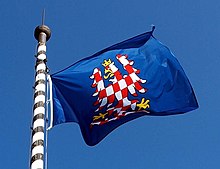Morávia

Morávia[1][2]

Localização da Morávia no mapa da União Europeia.
A Morávia (Checo: Morava; Alemão: Mähren; Polonês: Morawy; Latim: Moravia) é uma região da Europa central que constitui atualmente a parte oriental da República Checa. Suas principais cidades são Brno, Olomouc e Ostrava.
Seu nome vem do rio Morava, às margens do qual um grupo de eslavos se estabeleceu por volta de 500 d.C.. Os morávios falam diversos dialetos do checo.
Geografia |
A Morávia tem fronteiras com a Boêmia a oeste; a Áustria a sul; a Eslováquia a leste, e a Polônia e Silésia a norte.
Morávios ilustres |
Valentim Fernandes (14?? - Lisboa, 1518 ou 1519), impressor e tradutor.
Comenius (1592 - 1670), fundador da didática moderna
Nikolaus Ludwig von Zinzendorf (1700 - 1760), teólogo e bispo da Igreja Morávia que se dedicou a fomentar o diálogo entre as distintas confissões cristãs
Rochus Schüch (1788 - 1844), mestre de D. Pedro II do Brasil
Gregor Mendel (1822 — 1884), fundador da genética
Sigmund Freud (1856 — 1939), fundador da Psicanálise.
Edmund Husserl (1959 — 1938), filósofo fundador da Fenomenologia
Alfons Mucha (1860 — 1939), pintor e designer gráfico, principal figura do movimento Art nouveau
Joseph Schumpeter (1883 — 1950), um dos mais importantes economistas do século XX
Kurt Friedrich Gödel (1906-1978), matemático e considerado um dos maiores lógicos de todos os tempos.
Ivan Lendl (1960), tenista profissional
Petra Kvitová (1990), tenista profissional
Tomáš Berdych (1985), tenista profissional
Valentin Stansel (1621-1705) Astrônomo e sacerdote jesuíta
Oskar Schindler (Svitavy, 1908 – Hildesheim, 1974), industrial que salvou da morte 1200 judeus durante o Holocausto
Referências
↑ Svoboda, Zbyšek; Fojtík, Pavel; Exner, Petr; Martykán, Jaroslav (2013). «Odborné vexilologické stanovisko k moravské vlajce» (PDF). Vexilologie. Zpravodaj České vexilologické společnosti, o.s. č. 169. Brno: Česká vexilologická společnost. pp. 3319, 3320
↑ Pícha, František (2013). «Znaky a prapory v kronice Ottokara Štýrského» (PDF). Vexilologie. Zpravodaj České vexilologické společnosti, o.s. č. 169. Brno: Česká vexilologická společnost. pp. 3320–3324


